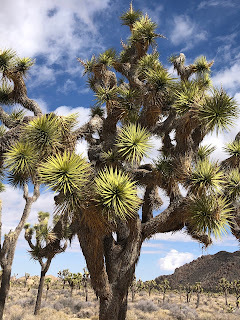Joshua Tree National Park is only about 40 minutes from Desert Hot Springs, and we felt we would be foolish to have driven all the way from the Bay Area and not visit the park. When we arrived at the ranger's station, we were able to talk to a wildly competent ranger who explained the layout of the park. As she handed Tyler his requested map, he asked her about the entrance fee. She asked a few questions and then advised that I was eligible for a discounted annual senior pass, and Tyler, young though he may be, could benefit from this discount because we were travelling together. I am quite delighted to be a card carrying senior supporter of our National Parks.
As the ranger suggested, we decided to take the park road to Key's View. The weather was chilly there, but the view was clear enough and high enough that we could see the desert stretch before us into distant mountains. When we looked to the left we could see the Salton Sea. What we could not see is that the lake supports no life, not even on its banks. Its toxicity is due to a high concentration of salt and chemicals that resulted from the reduction of the flow of the Colorado River.
We moved to a lower and warmer elevation and took a couple of short hikes. Here was where my out of practice packing was revealed. I had forgotten to pack my hiking pole. Despite my mastery of three flights of stairs at the hotel, I really cannot hike without my pole unless the ground is fairly level. My balance is undependable, particularly on a descent. We returned to the map.
I was very curious about a spot on the map marked Oasis of Mara, which is just off Twentynine Palms Highway. We drove north through the park and stopped at the visitor's center. We then walked the short loop around the oasis and learned some of the history. At one time the women of the Maara'yam, who were living in the San Bernardino Mountains, were having trouble giving birth to boys. For tribes who lived in isolated wilderness environments, both male and female children were needed to ensure the tribe's continued existence. A medicine man told them to go into the desert to the first place where they found water. He assured them that this would be a good place to live and "many baby boys would be born." The fathers were instructed to plant a palm tree every time a boy was born. Eventually, 29 palm trees would be planted. There is now a town and a highway known as Twentynine Palms. I am not sure that is the respect that this area deserves, but at least some sense of connection is kept.
The oasis is small, and certainly not lush as the word implies, at least to one who has grown accustomed to our terrain here in the Bay Area. Yet, to the Maara'yam, this oasis is a place of healing and the palms, like all plant and animal life, are ancestors. In other words, it is a holy place. We European Americans need these reminders of viewing land not a potential development site or dumping ground, but as a sacred living entity. As we walked, we came across a woman teaching some young people about their ancestors. Witnessing that small gathering gave me hope. I like to think that as we turned left on Twentynine Palms Highway to return to our hotel, we did so with a little more knowledge and respect. Sister Water, as St. Francis called her, continues to find a way to make her ways known to us. Let us be grateful, for we cannot live without her. Surely the Salton Sea has taught us that much.
In the next day or so, I will share Water, Part 3.
image: A beautiful Joshua Tree. I really could not get a good picture of the oasis. Perhaps my vision was just not ready to see. However, once our eyes became acclimated, we noticed several other oases. These are formed when the earth's crust is cracked, as on a fault line. The San Andreas fault stretches into this park, but there are other fault lines as well.

No comments:
Post a Comment